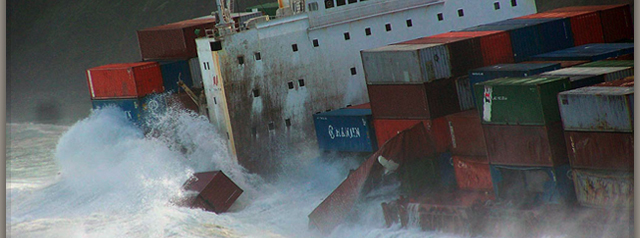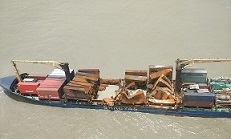The documentation procedures for cases involving salvage & GA are complex. It is important to appreciate that salvage and GA claims are completely separate even though they may arise from the same incident.
Salvage
Salvage is a claim brought by a third party volunteer who has assisted the ship and cargo to save it from a peril. Salvors have a lien to enforce their claim against the salved property as a reward for their successful intervention. The salvage may be performed under a Lloyds Open Form contract (LOF) or under common law. LOF is the most common so we will deal with the procedure under LOF.
The salvors will decide the amount of security required, which is usually a percentage of the value of the salved property.
In order to decide the quantum of the security and to identify the cargo it is necessary for us to obtain from you the B/L, commercial invoice and insurance policy. If the invoice is not on CIF terms, we need the appropriate freight and insurance amounts to be able to calculate the CIF values.
Salvage security must be lodged to the satisfaction of Lloyds for this amount to release the salved property. This security must come from a UK based guarantor acceptable to Lloyds, or in the form of a cash deposit. Dolphin’s corporate salvage guarantees are accepted by Lloyds. Since the Dolphin guarantee is a personal guarantee there is a bail fee from 0.75% of the guarantee amount. Dolphin guarantees can be arranged and sent to Lloyds in a few hours.
Once the security is accepted by Lloyds the cargo is then released. We then assess your salved values, taking into account any damaged or lost cargo. The salvage claim can be settled by us on your behalf, either by negotiation or arbitration, either of which we can handle in-house.
Amounts paid in salvage are added to any other claims against the responsible parties and recovery of all losses and any additional costs incurred are pursued by us in the usual fashion.
General Average
“There is a GA act when, and only when, any extraordinary sacrifice or expenditure is intentionally and reasonably made or incurred for the common safety for the purpose of preserving from peril the property involved in a common maritime adventure”. [York-Antwerp Rules – Rule A.]
History
In times gone by, merchants commonly used to travel with their goods on board the vessel. When the common maritime venture (consisting of both ship and cargo) got into difficulties, in some cases this could be cured by jettisoning some cargo. However there were understandable squabbles and delays over whose cargo should be thrown overboard. Obviously while this was decided, the common maritime adventure was in peril and could be lost.
The concept of General Average was developed in order to deal with this problem.
Basic elements of a GA casualty
There are four elements that must be in place for GA to legitimately exist.
1.Sacrifice or expenditure. This must be extraordinary. Routine expenses which would have been incurred in the normal course of events are not part of GA.
2.The GA act must be intentional and reasonably made. The principle is that the act or expense should be deliberate. It cannot be accidental or an inevitability.
3.There must be peril. The peril should be real and significant. If there was a belief that there was peril, but in fact there was none, this will not be GA. The only exception to this is an engine breakdown in port. There is no peril, in that the ship could in theory sit there indefinitely, but market practice dictates that it is treated as such.
4.The act or sacrifice must be for the common safety in a common maritime adventure. If only one party benefits, or if the act was not for the common safety, it will not be a GA act.
Please note the distinction between voluntary sacrifice and accidental damage ? the former is within the scope of GA, the latter is not.
Parties to GA
There must be more than one interested party to a GA. Only those who have an interest in property at the time of the casualty are parties to the GA. If your cargo is discharged before or loaded after the casualty, you will not be a party to the GA.
Typically, the parties will be the shipowner, cargo owner(s) and sometimes the charterers, who will have bunkers on board.
It is important to note that any party to the venture can declare GA.. Although usually in practice the shipowner is the party who declares GA, in some cases shipowners may not have an interest in declaring GA (because they may not want to contribute to sacrificed cargo). An example of this could be a cargo fire which results in wet damaged cargo being sacrificed in fire fighting. The shipowner may be liable to contribute in GA to the sacrificed cargo, but by not declaring GA, he may avoid doing so. In such an instance, cargo interests may wish to declare GA.
Typical procedure after a GA casualty (from cargo interests’ perspective)
a) Declaration of GA
The Master will usually be the first to be aware of a casualty giving rise to a potential GA and will make a declaration. The shipowners will usually appoint GA adjusters who are appointed by shipowners “in the General Interest” who may in turn may appoint a General Interest surveyor to look at any damage to ship and/or cargo.
At this stage, if cargo interests have significant amounts at stake, they should also collect evidence and make their own enquiries into the cause of the incident.
The Adjuster will be responsible for collecting security and performing the adjustment. The procedure is as follows-
b) GA Security
Shipowners have a posessory lien over the cargo for GA claims in most jurisdictions. In other words they can refuse to deliver cargo that is subject to a GA claim without receiving security for GA claims. It is important to obtain advice on the form of the guarantee to ensure that additional liabilities are not being incurred. We do not charge for issuing such a non-personal guarantee on behalf of underwriters.
1. General Average Bonds will be requested from the cargo owners. The wordings should be reviewed and they should be signed by the cargo owners and forwarded to the GA adjusters with copy to Dolphin.
2. A GA guarantee is also usually required. This is a separate document to the GA Bond and guarantees the payment of GA contributions. This is generally provided by cargo underwriters.
3. The GA guarantee is usually issued by us as your agents, i.e. it is not a Dolphin personal guarantee but is signed on your behalf. In order to issue the GA guarantee we need to receive your authority to sign as your agents. We also need to obtain from you the B/L, commercial invoice and insurance policy. If the invoice is not on CIF terms we need the appropriate freight and insurance amounts to be able to calculate the CIF values.
4. Sometimes, a GA guarantee signed by us as agents for the insurers is not acceptable to the GA adjusters. In such cases a Dolphin personal guarantee will usually be accepted, although the 0.8% bail fee would apply.
Once the security is accepted, the cargo can be released. We will then assess the contributory values, taking into account any losses or sacrifice, and submit these to the Adjusters.
c) Contributory values
Since the parties to the common maritime adventure make contributions pro-rata to the values at risk – the “contributory values”, these need to be determined. These are taken to be the value of the goods at the discharge port i.e. the CIF value less any deductions that are made e.g. for damage to the cargo. If there is sacrifice being claimed, the adjusters must be notified accordingly.
d) GA disbursements
The GA adjusters will collect details of the GA disbursements. These will be primarily from the shipowners but may be from other parties to the common maritime adventure.
e) Salvage
It is important to note that whilst salvage services may be involved in a GA casualty, the salvage and GA securities are independent of each other. The claim for salvage generally requires security to be provided direct to salvors and this is independent of any GA security required. We are well placed to assist with the provision of both types of security.
The only area of cross-over of salvage into GA will be the inclusion of amounts paid in salvage into GA as part of the expenditure incurred by the parties. This has been excluded for the YAR 2004, but will still be the case for previous YAR rules which are still in force in the majority of cases.
f) GA Adjustment
The adjustment will then be produced and the contributions of the various parties calculated. The general aim of the calculation exercise is to determine what the fair pro-rata contribution is from each party. Depending on the number of different interests and the complexity of the matter, it can take a year or more for the adjustment to be issued, and if there is salvage involved then it cannot be issued before the salvage claim is resolved, which in itself can easily take a year.
g) Defences
It is a common misconception that just because there is a claim for GA and an adjustment, that it is necessary to pay!
A review of the adjustment is necessary to ensure all the allowances are correct and the contributory values are in order.
Furthermore, and most fundamentally, a claim for GA can successfully be defeated if the cause of the incident is unseaworthiness. The vast majority of GA cases are compromised or rejected. It is not necessary to pay the GA in the first instance and then seek recovery.
Incidentally, if cargo interests decline to pay GA, the shipowners can normally recover from their P&I insurers for cargo?s proportion of unpaid GA.
h) Recovery from third parties
In some cases, the GA may arise for reasons which the shipowner is not responsible for, or for which he has a contractual defence. In some of those cases, it may be necessary to settle the GA claim. However, it may be possible to make a recovery from a third party, e.g. a shipyard for making a negligent repair, or a colliding vessel bearing some blame for the collision.
It can also be the case that cargo interests that have made sacrifice will need to recover from other cargo interests and the shipowners. These parties may not pay voluntarily and action may be needed to persuade them to settle.
Summary
In summary, in order to assist you, we will need the following documents-
1.copy of the commercial invoice
2.copy of insurance policy
3.copy of the B/L
4.Your confirmation that we are to place the security on your behalf and that you will provide us with counter-security by way of our standard letter of indemnity.
Kindly note that if we are to place our personal guarantees, it is conditional on Dolphin being instructed to handle all negotiations arising from the GA and Salvage case concerned and subject to our standard terms and conditions.








